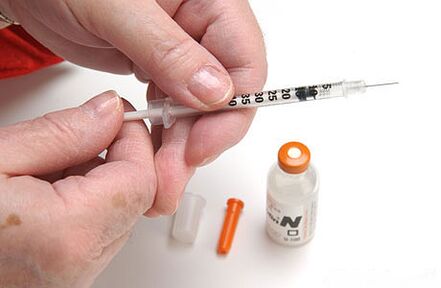THE ISSERNA - The hormonal secret of the processor plays an important role, guaranteeing the constancy of blood sugar. Diabetes mellitus is a consequence of a shortage of this hormone. The complications caused by the disease often lead to death. The basic principles of diabetes treatment are rigorous adherence to the diet, taking drugs or insulin injections, monitoring the level of blood glucose, observing your body so as not to lose the first signs of complications.

Pathogenesis of the disease
Diabetes mellitus is a persistent violation of the synthesis of the insulin hormone and its interaction with the tissues in the body.
Insulin elaborates the sugar received in glucose and passes it through cell membranes. Therefore, the hormone lowers the degree of sugar in the blood and provides the nutrition to the cells. The deficiency of insulin with the sensitivity of the compromised tissue leads to the fact that glucose does not participate in the metabolism and continues to circulate through the body. Biology not only of carbohydrate metabolism is lost, but also fats, proteins, water jump.
The rise of sugar increases the quantity of lipid fractions in the bloodstream, which contributes to the development of atherosclerosis. The transformation of glucose into glycogen slows down and the body begins to use fat as resources. Fatty acids break and appear ketone bodies that cause damage to the central nervous system.
Causes and current
The production of insulin is disturbed due to the damage to the synthesis of beta cells. The main risk factor for diabetes is the inheritance, which significantly improves the effect of other factors. The probability of getting sick increases with age. The causes of diabetes:
- The failure of the immune system. It causes the cell attack with a pancreas with protective proteins.
- Obesity. It reduces the reaction of the hormone receptors due to an excess of adipose tissue (the cause of the type of diabetes).
- Pancreatic disease. Call the death of the cells that secrete the hormone (pancreatitis, cancer).
- Virus infection (chickenpox pathogens, rosolia, influence).
- Nervous tension.
The disease exists in the role of independent pathology and as a temporary symptom. The causes of diabetes mellitus may be the consequences of the work errors of the endocrine organs (hyperthyroidism, feocromocytoma). The symptomatic excess of glucose detected during pregnancy (including the use of in vitro fertilization) is called gestational diabetes. Hyperglicemia occurs as a side effect of the prolonged use of some drugs (glucocorticoids, estrogen, psychotropic drugs), if exposed to toxic substances.
Hyperglicemia reports diabetes only in the presence of insulin errors, the appearance of symptoms of sugar disease.
Types of diabetic pathology

Diabetes mellitus is a violation of the metabolism of carbohydrates and water in the body.
The classification of those who determine two main types of disease: dependent on insulin (type I) and the opposite form -dependent on insulin (type II). They differ in reasons for the appearance and details of the pathogenesis, the nature of the course, have their treatment characteristics, but the consequences are equally dangerous.
- The diabetes dependent on insulin (youth) is caused by the autoimmune aggression of the body. Interested endocrine beta cells are not able to produce insulin in the necessary doses, its constant administration from the outside is required. People under the age of 30, thin. The disease starts suddenly, progresses quickly and has a serious course.
- Insulinone -Denandente. The causes of diabetes disease of this type are inheritance and obesity. Insulin can be produced in sufficient quantities, but the cells are not sensitive to it. This is due to an excess of nutrients. Diabetics over 40 have a complete physique. The acquired diabetes develops gradually, it proceeds permanently. Most patients suffer from this type of disease.
Severity
The severity of the development of diabetes mellitus in the blood sugar phase, glucosuria, the degree of dysfunction of the target organs, the presence of complications are determined, which shows the body compensation skills. There are 4 degrees of gravity. If diabetes passes slightly, the treatment and nutrition are selected correctly. The degree of diabetes and symptoms is described in the table.
| Grade | Blood sugar, mmol/l | Urine readings | Symptoms |
|---|---|---|---|
| 1st (light) | No more than 7 | The protein is normal, glucosuria is absent | Absent |
| 2nd (Middle) | 7-10 | Glucose up to 40 g/l; Ketosis and ketoacidosis appear periodically | Malfunctions of cardiac activity, visual apparatus, nervous system, manifestation of angioneropathy |
| 3rd (heavy) | 10-14 | Persistent glucosuria 40 g/l, many protein bodies, ketonic | Improved effect on organs, a drop in vision, pain and intertwine in the legs, increased blood pressure |
| 4th (superpolar) | 15-25 | More than 50 g/l of glucose, intense proteinuria and ketoacidosis | Strong defeat of all organs, kidney failure, diabetic coma, gangrene, ulcerative outbreaks on the legs |
Characteristic symptoms of diabetes

The clinical signs of the disease in most cases are characterized by a gradual course.
Diabetes in adults may not immediately declare itself to the development of complications. Type I diabetes is quickly developing with blood sugar and high coma. The intensity of the symptoms of acquired diabetes is associated with the degree of deficiency of insulin, the individuality of the patient's body. It is necessary to perform a test to determine the degree of blood sugar, if one of the symptoms appears:
- An unusual feeling of the dry mouth;
- the inability to extinguish thirst;
- Improved diuresis: an increase in the amount of urine displayed;
- quick weight loss or weight gain;
- Itchy and dry skin;
- reduced sensitivity to the skin on the feet;
- numbness, tingling in legs and arms;
- convulsions, gravity in the legs;
- Purulent skin processes caused by slow regeneration of the skin;
- low resistance to infections;
- constant feeling of hunger;
- Vaga vision;
- increase in blood pressure;
- swelling of the face and legs;
- Head pain, selling off;
- Smell of body acetone;
- dark of consciousness;
- Pseudo -Peritrina (false "sharp stomach").
The consequences of blood sugar
Diabetes mellitus is an insidious disease. The excess of blood sugar damages blood vessels, causes damage to the wall. Excess glucose turns into fat deposits. This leads to obesity and steathogepatosis (accumulation of lipids in liver cells). Glucose causes the glycalization of membrane proteins. The oxidative process is able to cause compromised protein functioning and the appearance of toxic to -products. Defective proteins cause disorders in the structure of the organs. The accumulation of toxins and ketones causes damage to the patient's nervous system, up to disorders in the mind and coma. Excessive blood cholesterol is deposited on arterial walls in damaged areas and shapes of atherosclerosis plates, contributing to the angiopathies of the eyes, the legs of the legs and other organs.
The degree of excess of the level of blood sugar determines the complexity of the course of the disease.
The risk of complications

Complicated diabetes mellitus involves the danger of the life of a sick person, so it is so important to identify the disorder over time and start treatment. The disease is aggravated for 10-15 years. The complications that appear advanced quickly and it is not easy to do it. Acute complications with primary diabetes (hypo- and hyperglycaemia) are caused by strong fluctuations in blood sugar. A list of states that complicate the disease of diabetics:
- Hypoglycaemia - A strong drop in glucose less than 3 mmol/l can lead to a hypoglycaemic coma.
- Hyperglicemia - Lift the sugar indicator greater than 6 mmol/ends with a hyperglycemic coma.
- Ketoacidosis - Damage to neurons with ketone bodies, causing someone.
- Neuropathy - Damage to the nerves of the suburbs.
- Diabetic foot, trophic ulcers and deadlines of the lower limbs caused by angiopathy and neuropathy.
- NEFROPATIA - Damage to the small capillaries of the kidneys, which interrupts the functioning of the urinary system.
- Retinopathy - Skipping with the vascular walls of the retina.
- Cardiomyopathy - Cardiac muscle disorders.
- Encephalopathy - Pathology in the brain vessels.
Diagnostics
The diagnosis of diabetes determines the type of disease, gravity, presence of lesions of the internal organs. Studies can be conducted repeatedly to evaluate the degree of progress of the disease and the effect of the treatment. The diagnostic criteria for diabetes are characteristic signs of diabetes and the degree of lifting of glucose. To confirm the diagnosis, urine and blood tests, instrumental studies are conducted:
- indications of glucose on an empty stomach;
- Glycemic profile (daily vibrations);
- blood at the insulin level;
- a study on glucose tolerance, the sugar relationship on an empty stomach and after the consumption of carbohydrates;
- Analysis for glycolized hemoglobin;
- Blood for biochemistry;
- General urine analysis that detect glucose, proteins;
- electrolytic blood test;
- Acetone indicators in the urine;
- inspection of the eye view;
- Ribell test for kidney damage;
- Ultrasound of the abdomen;
- cardiogram to verify the function of the heart;
- Capillaroscopy, reuroscopy of the lower ends determines the degree of defects in the pots.
In healthy people, the level of glucose in the blood is in the interval of 3, 3-5, 5 mmol/l.
Disease treatment

In the presence of suspicion of diabetes mellitus, this diagnosis must be confirmed or refuted.
Diabetes mellitus is a chronic pathology that must be treated for life.
The principles of diabetes treatment: sugar control in the glucometer of blood flow and prevention of complications by observing the diet and taking drugs.
An endocrinologist can treat the disease, a cardiologist, a neuropathologist, an ophthalmologist, a vascular surgeon are connected.
Modern treatment methods - medicines, diet, physical education - slows down the progression of the disease.
Medicines
The doctor selects the medicine, given the type of illness. Type 1 diabetes mellitus requires only insulin therapy, type 2 diabetes can be treated with sugar. The tablets act on the pancreas, increase the sensitivity of peripheral fabrics. These drugs are used:
- Sulfanilamides.
- Biguanides.
- Insulin preparations of a short and prolonged action. Simple insulin is administered 3-5 times a day and long-lasting insulin up to 2 doses. Perhaps a combined use of drugs.
Diet with diabetes
The treatment of diabetes certainly includes a diet with the selection of the calorie content, excluding easily digestible carbohydrates, sweets. Diabetes requires fractional energy. At the same time, the relationship between nutrients remains close to physiological. The sugar is replaced by xylitol or sorbitol. In the average and serious forms of the disease, diet is recommended n. 9. It is allowed to eat vegetable soups, low -content types of fish and meat fat, acid and cheese milk products, cereals (buckwheat, barley oatmeal), fruit, sweet and acidic berries. You can never eat slaughter, desserts, fatty dishes, rice semolina, pasta, grapes, savory and marinated vegetables.
Prevention
The occurrence of type 1 disease cannot always be influenced, as it can cause a viral pathogen. The reason for the development of type 2 diabetes is considered an unhealthy lifestyle, especially in people with hereditary prerequisites. Prevention measures if sugar disease is diagnosed: proper nutrition in small portions with a minimum of easily digestible carbohydrates and fats, maintaining an optimal body weight. Hypertension is also performed with the control of blood pressure numbers. Periodically, you have to give blood for the content of glucose and fractions of lipid blood. Moderate physical activity will help keep the body in tone.
























